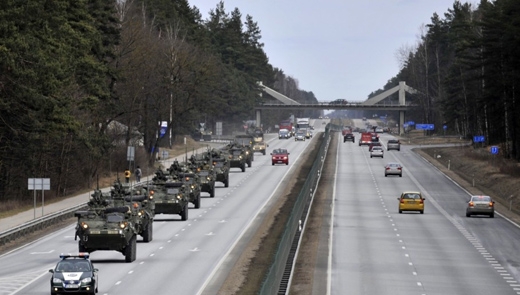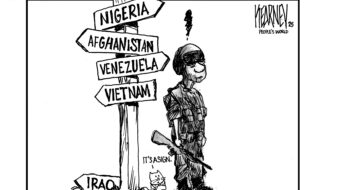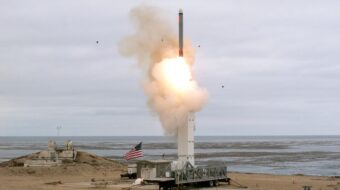
In the days of horse cavalry, a “dragoon” usually meant a heavily armed soldier, mounted on a large, strong horse, who could either fight as a cavalryman (with pistol and sword), or as an infantryman (with musket or carbine). Later these troops became known as “mounted infantry.”
Some of the earliest dragoons were used by King Louis IV of France to harass the Protestant Huguenot population of certain regions of France so as to force them to either convert to Roman Catholicism or leave the country. According to the Chairman of the Communist Party of Bohemia and Moravia, Voijtech Filip, the same use was made of dragoons in Bohemia by the Catholic Austrian government to harass Czech Protestants, also during the 17th century. In France, these harassment campaigns were called the “dragonnardes.” One also hears sometimes about someone being “dragooned” into some activity, i.e. forced against her or his will.
In our own times, the United States and most other countries do not use horse cavalry very much any more, and the appellation “dragoon” now mostly applies to some armored units.
Dragoons are in the news in Europe this week, in the form of operation “Dragoon Ride.” Armored troops commanded by U.S. General Ben Hodges, top commander of U.S. troops in Europe, paraded from Saturday through Wednesday through Latvia, Lithuania, Poland and the Czech Republic. The column consisted mostly of armored personnel carriers and some tanks, from the 3rd Squadron of the 2nd Cavalry Regiment based in Germany, with some aircraft also.
The U.S. military announced that this show of saber-rattling was supposed to “reassure” U.S. and NATO allies, but it is also clear that it was aimed at challenging Russia in the context of the ongoing troubles in neighboring Ukraine, where the right-wing government in Kiev has been battling opponents in Luhansk and Donestk provinces in the industrialized Donbas, in the East of the country. Although a truce is holding for now this could break down and more people than the at least 5,000 people already killed could lose their lives.
The right-wing Ukrainian president, Petro Porochenko, and prime minister, Arseny Yatsenyuk, have been calling for armed U.S. and Western aid, based on the dubious idea that Russia has plans to push eastward and invade other European countries. The tenuous hold that these gentlemen have on reality was illustrated by Yatsenyuk’s reference to World War II as the time when “Russia” invaded “Germany and Ukraine.” By depicting the Russian bear as a singular danger to the world, the Ukrainian government leaders also distract attention from their country’s state of near economic collapse, and the presence in their government and fighting forces of neo-Nazi and fascist individuals and groups.
But this narrative also suits the convenience of major governmental and extra governmental power centers in the United States who are determined to weaken Russia for other reasons, including Russia’s economic rivalry with the west and its inclusion in the BRICS (Brazil, Russia, India, China, South Africa) of emerging powers who challenge U.S. and European Union economic hegemony. And this has led to the playing of dangerously provocative games, amounting to pushing NATO’s armed forces right up against Russia’s borders.
The corporate press here in the United States claims that the “dragoons” were welcomed as some sort of liberators from the Russian threat. But there were strong protests against them in the Czech Republic.
In Prague, the Czech capital, at least 1,300 people turned out to protest the “Dragoon ride.” Organizations that mounted protests included especially the Communist Party of Bohemia and Moravia, which has the third largest number of seats in the lower house of the Czech parliament (33 seats out of 200), plus pro-peace organizations. Other organizations involved were the “NO to the Bases Initiative, the Labor and Solidarity Alliance, the Movement for Direct Democracy, Students Against Racism, STOP Church Restitutions Initiative and the Party of Democratic Socialism.
The Communist Party of Bohemia and Moravia criticized Dragoon Ride as a provocation designed to exert pressure on the Russian Federation, a risky action that could heighten tensions for several years. They also criticized the Czech government for not informing the Czech Republic nor even raising the issue in the context of the Czech parliament before agreeing to the passage of the U.S. troops through their national territory.
At the demonstration against “Dragoon Ride” in Prague, speakers also denounced Czech membership in NATO as contrary to the interests and wishes of the people.
There was also a much smaller pro-U.S. demonstration.
Photo: U.S. Army Stryker vehicles roll down a highway in Riga, Latvia, on Sunday, March 22, 2015, as part of Operation Dragoon Ride. The exercise took place amid ongoing tensions between NATO and Russia. | Oksana Dzadan/AP










